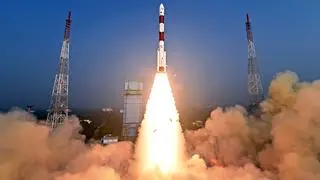ISRO has put its disappointment over the not-so-successful moonlanding behind it and has begun to look forward — to the next missions. On the cards is a clutch of launches, starting from PSLV 47 later this month. But the next big milestone is the testing of the semi-cryogenic engine — in Ukraine.
The semi-cryogenic engine is fully ready now, S Somnath, Director, Vikram Sarabhai Space Centre, Thiruvananthapuram, a unit of ISRO, told BusinessLine . When ready for operation, the semi-cryo will raise ISRO’s carrying capacity from 4 tonnes to 6 tonnes, all the way up to the Geosynchronous orbit, 36,000 km above earth.
India and Ukraine signed, on June 2, 2005, a Framework Agreement for cooperation in the peaceful uses of outer space.
It is believed that this also involved transfer of blueprints for a rocket engine. Even the liquid propellant-fired Vikas engine, used in GSLV’s lower (core) stage was first tested in France, recalls a former ISRO executive.
Technological leap
The ₹1,800-crore SCE-200, where 200 refers to the number of tonnes of thrust it kicks, is a big technological leap. It is a very complex machine and its development is no less a technological challenge than Chandrayaan-2, say sources in ISRO.
The cryogenic engine that sits at the top of the GSLV rocket is a small one, of 20 tonnes of thrust, which is only slightly more than what a Pratt & Whitney 1000G engine, fitted onto a A320 aircraft, delivers.
After all, the cryogenic engine does not need to carry a very heavy load on its head — the heavy lifting is done by the lower stages of the rocket, which detach and fall into the sea after they expend themselves.
On the other hand, the semi-cryogenic engine, which is based on Ukrainian company KB Yuzhnoe’s RD-810 engine design, will be located at the lower part of the rocket and is meant to do the heavy lifting. It generates a whopping 200 tonnes of thrust; the pressure inside its combustion chambers is about 190 times the atmospheric pressure that we feel on our bodies all the time.
The SCE-200 is good in another way too — its fuel is kerosene, kept in the tank at room temperature. (The oxidiser is liquid oxygen, kept in cryogenic conditions so that it remains liquid.)
Kerosene is a far ‘greener’ fuel than the unsymmetrical dimethyl hydrazine (UDMH) that is currently used in Indian rockets, which is also highly toxic and carcinogenic.
A new AVATAR
ISRO’s rocketry has many ambitious milestones to cross. First, there is the re-usable launch vehicle but the real meat is to come later, hopefully by 2025, when the AVATAR vehicle will become operational.
Jointly developed by ISRO and Defence Research and Development Organization (DRDO), AVATAR will be a space plane that can take off and land from airfields, like commercial aircraft. It will be a technological marvel, which will collect air on its way up, separate oxygen from it and store the gas on-board for space use.
Apart from bringing down the cost of launching satellites incredibly, to under $100 a kg, the AVATAR is also expected to make ‘space solar stations’ possible. These are solar power plants in space that will produce electricity and beam it down as microwaves.
Today, taking up tonnes of material to build such a station makes it uneconomical, but AVATAR could favourably invert the economics of it. Incidentally, China has made substantial progress in building the first ever SSS.
In the meantime, ISRO is also trying to master the technology for ‘docking’ with a space station, so that Indian astronauts and supplies can be ferried up and down. ISRO indeed has little time to grieve over Chandrayaan-2.







Comments
Comments have to be in English, and in full sentences. They cannot be abusive or personal. Please abide by our community guidelines for posting your comments.
We have migrated to a new commenting platform. If you are already a registered user of TheHindu Businessline and logged in, you may continue to engage with our articles. If you do not have an account please register and login to post comments. Users can access their older comments by logging into their accounts on Vuukle.